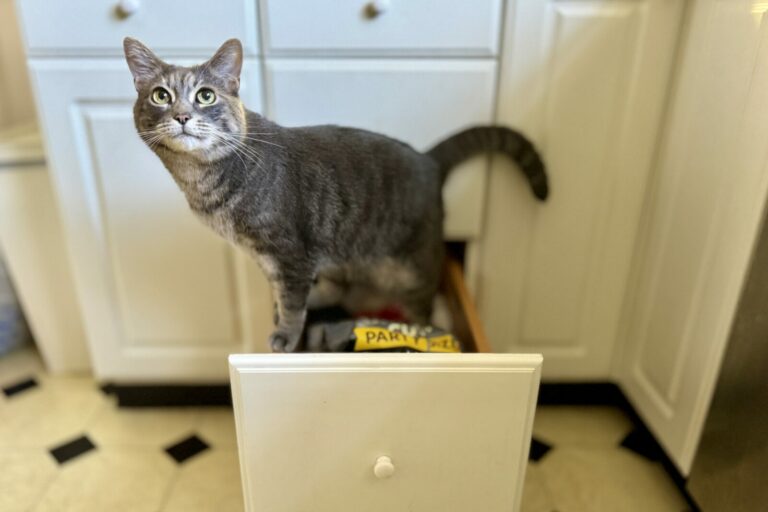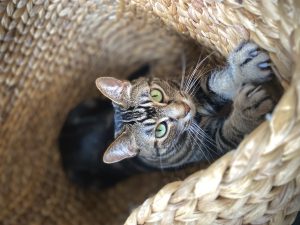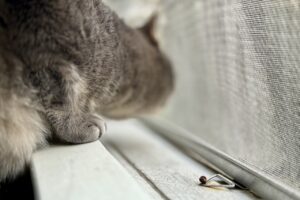33 Things to Cat-Proof in Your Home – a Quick Start Guide
Cat-Proofing – At a Glance
Getting a new kitten? Or just looking to make your house a little more cat-safe? This is your quick start guide to cat-proofing your home.
There’s a lot that goes into cat-proofing if you really want to be thorough, so you might want to check out our other articles that go into detail about specific areas of cat-proofing and how to handle them properly.
In the meantime, use this checklist to see where you might need to make improvements. Of course, all of this applies to kittens too!
Let’s dive in – anything here you never thought of?
Checklist: 33 Ways to Cat-Proof or Kitten-Proof Your Home
1. Window Screens
Check that screens are intact and firmly in place to prevent falls or escapes.
2. Draw Cords
Keep blind and curtain cords out of reach by looping or tying them up, eliminating a strangulation hazard and deterring cats from playing with them.
3. Office Supplies
Store office supplies like paper clips, staples, thumb tacks, and rubber bands in closed containers to prevent accidental ingestion by curious cats.
Relocate breakable items from surfaces within your cat’s reach to prevent damage and potential injury from knocked-over treasures.
4. Vases
Use museum putty to make vases harder for your cat to tip over. Try vases that are short, stout, and heavy/wide at the bottom.

5. Appliance Doors
Keep the doors shut to your washer, dryer, dishwasher, oven, and fridge. And always, always double-check that your cat isn’t inside before hitting the start button.
6. Compost and Trash Cans
Make your compost and trash inaccessible by using containers with lids or step-pedals. Or use an under-counter, in-cabinet, or pull-out system.
7. Plants
Do your homework and make sure none of your houseplants or flowers are toxic to cats. This includes cut flowers – there are some big no-no’s in the flower department!
8. Toilets
Toilets are a drowning hazard for cats. Get everyone in your household in the habit of always leaving the toilet seat down.
9. Candles
Flames and cats don’t mix. Cats will get close enough to candles to singe whiskers and fur. And their awareness of where their tail is in space is not great, making candles a huge fire risk if they’re tipped over. Use electronic candles.
10. Electrical Cords and Wires
These look like toys to cats. Cover up your cords and wires and don’t take the chance of your cat getting electrocuted, or a damaged cord starting a house fire. Use bitter apple spray for those that can’t be covered easily.
11. Holidays, Birthdays, & Parties
During holidays, use cat-safe ornaments and spray string lights with bitter apple if your cat is tempted by them. Don’t use tinsel or ribbons at all. Get rid of ribbons from party balloons and gifts right away – never let them lay around.
12. Stovetop and Oven
Use knob covers when stove isn’t in use to prevent your cat from turning it on. Use burner covers after cooking to prevent your cat from stepping onto a hot burner. (My dumb oven has a touchscreen so I actually have to unplug it to keep cats from turning it on – annoying but necessary!)
13. Human Medications
Keep all medications and supplements secure. Don’t leave any tablets or capsules lying around, as many are highly toxic to cats.
14. Cabinets and Drawers
Put child locks on cabinets and drawers that contain chemicals, cleaning supplies, medications, of any other hazards.
15. Bookshelves and Tall Furniture to the Wall
Use earthquake straps or other tethering device to prevent tall and heavy furniture from tipping over.
16. Balcony
Use panels or screens to securely cat-proof your balcony. It’s very difficult to do this well – either do it right or simply just don’t let your cat on the balcony.
17. Curtains and Drapes
Tie curtains and drapes up out of reach, or remove them in the beginning until your cat is trained to use the scratchers and cat trees you’ve put in place. It’s much easier to prevent a curtain habit from forming than it is to stop it once it’s already happening.
18. Household Chemicals
Keep household chemicals, like cleaning supplies, securely inaccessible to your cat.
19. Mothballs
Mothballs are highly toxic to cats.
20. Sofas
Seal off any openings under your sofa that might allow your cat to crawl up inside. This will prevent getting stuck or hiding in a place you can’t get to in an emergency.
21. Rocking Chairs
Use rocking chairs with extreme caution if it’s possible your cat is in the room.
22. Reclining Chairs and Sofas
Cats love to hide under things, making the moving parts of recliners potentially lethal. I think it’s better to simply not have any at all, and to replace them with different furniture if you do. It’s just not worth the risk.
23. Plastic Bags
Keep plastic bags securely closed away. They are a suffocation and strangulation risk. The handles are also a hazard similar to paper bags (see #23). Don’t leave plastic bags out in the open.
24. Paper Bags
Remove handles from all paper bags. Cats can easily get their head caught in the handle, which causes them to freak out and thrash around as they try to free themselves.
25. Essential Oils, Potpourri, & Deodorizers
Many are toxic to cats. Do your homework and make sure you aren’t using any that will cause harm.
26. Bathroom Products
Toothpaste is toxic to cats. Floss is similar to ribbon – if ingested, it can cause severe or lethal damage to a cat’s intestines.
27. Tablecloths
Many cats are tempted to play with the parts of a tablecloth that hang down. If this happens with your cat, whatever is on the table will come down right along with the tablecloth.
28. Laundry Room Stuff
Dryer sheets, fabric softener, and detergent are all toxic to cats. Keep them securely tucked away in a container or cabinet.
29. Crafting stuff
Keep thread, yarn, and needles put away when you’re not crafting.
30. Breakable Valuables
Cats love to push things off of shelves just to watch them fall. Put away or relocate the fragile stuff that’s accessible to your cat. You can also rearrange furniture so that there’s nothing to jump from to get up to a high shelf.
31. Beds
The space below a bed is a go-to hiding spot for cats. All three of mine do it. Fill in the space completely with under-bed storage, or just use a platform bed to make it impossible. Especially with queen or king size, you don’t want to find yourself unable to reach your cat in an emergency.
32. Stairs, Banisters, & Landings
Try to predict where your cat will attempt jumps from/to. Prevent the jumps that might injure or trap your cat.
33. Doors
Check your exterior doors to make sure they latch securely to thwart any adventurous escape attempts. Don’t forget the door to the garage if you have one attached to your living space.
Final Thoughts
So there you have it – 33 things to check to make sure they aren’t a hazard to your cat. And congrats to anyone who had already toddler-proofed the house. You probably had 80% of your cat-proofing done!
But seriously, time to address any weaknesses in that cat-proofing game of yours. And we’re just scratching (rawr) the surface, here. Use our comprehensive cat-proofing guide if you want to get serious about it.

